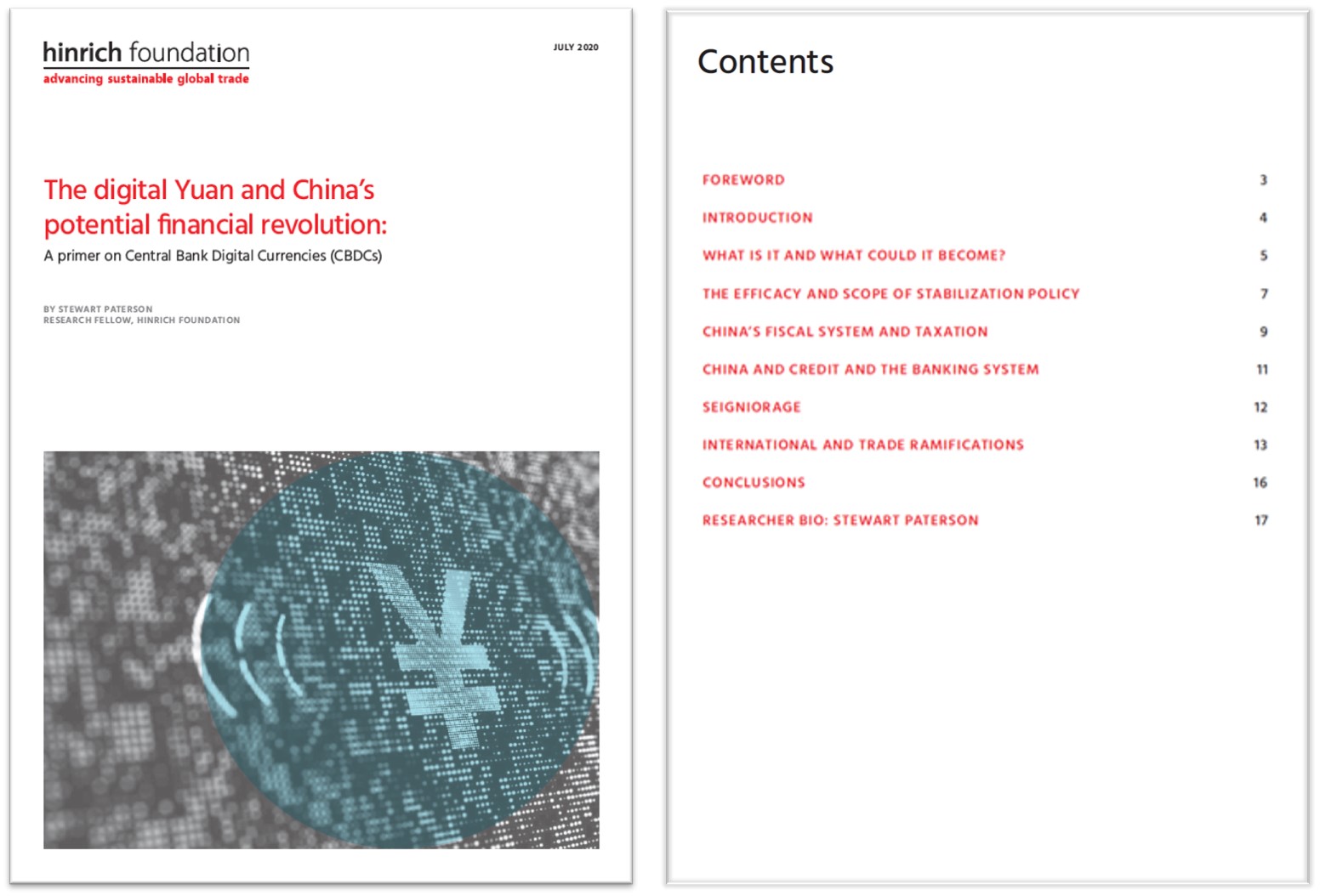Published 15 July 2020 | 8 minute read
China is trialing a Central Bank Digital Currency (CBDC) and the digital Yuan could displace physical cash over the next few years. This gives enormous power to the Chinese state and the trade implications are significant.
Download our white paper and read a summary below:

China is leading the way with the digital Yuan
China is leading the way among large economies in trialing Central Bank Digital Currency (CBDC). Its official name is Digital Currency Electronic Payment (DCEP). The digital Yuan, unlike Bitcoin and other private currencies, will be legal tender. Initially at least, it will be issued via Chinese commercial banks.
This could mark a change in the international monetary system
The Chinese trial of a CBDC comes at a time when the existing international monetary system is being questioned. To some, the Dollar Standard is seen as increasingly anachronistic in a world where the US no longer dominates the global economy and trade. Changes in the global monetary system have often been associated with shifts in the balance of power, changes in trading patterns and financial innovation. It is hard, therefore, not to view the potential for CBDC through the prism of renewed great power rivalry, China’s rise in regional economic dominance and its very significant role in the global trading system.
This paper offers an introductory look at the digital Yuan and CBDC generally with a view to assessing the possibility that such an innovation may change the way we look at money, identifying the efficiencies it may bring and forecasting the implications for the financial system and trade generally.
Differentiation between CBDC and existing forms of money will depend on design features, creating a wide dispersion of potential outcomes.
Digital central bank money already exists in the shape of commercial bank reserves at the central bank. Digital money, or near money, also already exists in the form of household and corporate deposits at commercial banks. How different the DCEP and other CBDCs turns out to be from existing forms of digital money and near money will depend upon many features but perhaps most important among these are:
- Whether or not it ends up replacing physical cash entirely
- Availability and quantity, i.e. is it rationed or not and is it available to everyone or just commercial banks and financial institutions?
- How it is made available, i.e. does distribution continue to take place through commercial banks or can households and corporates transact directly with the central banks thus by-passing the commercial banking system?
- The degree of anonymity that is provided to the users of CBDC.
These features in turn will determine the CBDC’s efficacy as a store of value and as a payment system, the shape and the stability of the financial system and the impact the CBDC has on meeting national objectives for monetary and fiscal policy.
Given the different forms that the Chinese CBDC, or any other for that matter, might take, it is worth considering some different scenarios and the impact it could have. The main areas of potential impact are on transactional efficiency and competition with payment systems; the efficacy of stabilization policy; the financial system’s stability and profitability; the fiscal system; and trade and international transactions.
China’s citizens have been rapid adopters of new payment systems
The people of China have been rapid adopters of new payment systems, where they have proved efficient to both consumer and merchant. Credit cards were slow to take off in China, at least in part because the merchants baulked at the fees. Alipay on the other hand, has been very successful and mobile payments have grown exponentially in recent years. Digital currency, which will not require internet connectivity but can be used by touching two devices, could bring the same efficiency to rural areas and by-pass the costs associated with existing payment systems. Longer term, this could lead to the phasing out of physical cash altogether and pose a challenge to existing payment systems.
The digital Yuan has potential implications for monetary policy
From a monetary policy perspective there are ramifications too. The limitations of monetary policy have become evident as interest rates have converged on the “zero bound”. While physical cash exists, it remains a potential substitute asset for bank deposits if banks charge negative interest rates. Digital cash could be charged a negative interest rate since it will be known to the central bank where all the cash is at any point in time. Furthermore, if households and companies will eventually be invited to bank with the central bank directly, by-passing the commercial banks, the quantity of money would become directly controllable by the central bank.
There are efficiency and compliance implications for the fiscal system too
There are also implications for the fiscal system. China’s taxation is highly centralized while its spending is largely decentralized. The digital Yuan will give the central bank, and therefore one can assume the party-state, complete visibility of transactions. This could close the “tax gap” leading to a higher tax take as the black economy is brought into the formal economy, reduce corruption, and facilitate a more decentralized taxation system—potentially in real time. The tax taking power of the State would be significantly enhanced.
The BRI and the tourism industry could provide fertile ground for internationalizing the digital Yuan
While some of the consequences of the digital Yuan outlined above depend on China making design choices that it has not yet committed to, the digital Yuan, as implemented in its trial phase, could increase its use in trade and international transactions. The tourism industry is perhaps the most obvious example, with outbound Chinese tourists spending the digital Yuan.
The Belt and Road Initiative (BRI) too provides an opportunity to expand the use of the Yuan, in its digitalized form, outside the borders of China. Foreign companies transacting with Chinese companies for supplies, workers being paid wages and financing of projects through digital Yuan loans are all possible ways in which the digital Yuan could be put into circulation through China’s infrastructure building program. If the digital Yuan were rationed (i.e., there was a limit on the amount created as a proportion of total money supply) then the digital version could potentially be exempt from capital controls in a similar way to the offshore Yuan, although there is obviously the risk that a dual exchange rate could emerge.
A possible prelude to greater capital account liberalization for China?
There are good reasons why the Yuan’s internationalization has been slow: capital controls, China’s current account surplus and the lack of a clear advantage to using the Chinese currency. If the digital Yuan provides the prospect of greater internationalization, going forward the Chinese authorities may be incentivized to relax the regulatory barriers that stand in the way of internationalization. If the BRI provides a way of putting Yuan into circulation outside China and if the efficiency of the digital currency provides a compelling advantage to its use, the CBDC may accelerate the growth in the Yuan’s international use.
A bifurcated global financial system?
The advantages for international trade of CBDC, in providing instant settlement and overcoming issues of trust could be significant. The potential for CBDCs to facilitate transactions, circumvent surveillance through SWIFT and thus help countries avoid economic sanctions will appeal to some states. It could also result in a bifurcation of the global financial system along geopolitical lines, with a loss of the positive network externalities that a unified system brings. Such a move would likely have a retarding impact on trade.
© The Hinrich Foundation. See our website Terms and conditions for our copyright and reprint policy. All statements of fact and the views, conclusions and recommendations expressed in this publication are the sole responsibility of the author(s).







